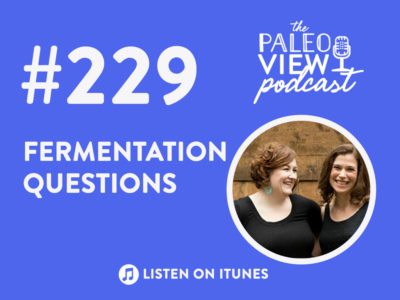In this episode, Stacy and Sarah tackle questions about fermentation. They discuss both how to ferment foods, and why you ought to be eating them.
Click here to listen in iTunes
or download and listen by clicking the PodBean Player below
![]()
If you enjoy the show, please review it in iTunes!
The Paleo View (TPV), Episode 229: Fermentation Questions
- Intro (0:00)
- News and Views (0:40)
- Happy New Year!
- Sarah is working on finishing Paleo Principles. Almost done!
- Stacy is coming back from her bereavement leave and answering her mail. Thanks for all the California suggestions!
- We’re going on the Warner Brothers Studio tour to see the Batmobiles and Sorting Hat!
- And we’re going to Pismo Beach for ATVs and whale watching!
- It’s pretty cool how you all know so much about us and can help us find the cool stuff!
- Sandra Lee asks (9:23): “Sarah and Stacy, I love the podcast, and appreciate how down to earth and real you are about life, family, sleep, food, all of it. I never miss an episode. I frequently recommend you, the podcast, and your books to friends and family. I’ve been making fermented vegetables for years and have always had questions. Now I’m asking them. It’s Fall and harvest time. There are tons of cabbages, carrots, and other fermentable veggies at the farmer’s market. I imagine the way people started fermenting was in their attempts to preserve the bounty for consumption long after anything fresh would have spoiled. I took a picture of the jars sitting on my kitchen floor, but realized that you don’t have a way for including attachments. How long do fermented vegetables last? I keep them in the refrigerator, putting a huge premium on cold space. I expect them to be good until harvest time the next fall. So I am now consuming what remains from last year’s sauerkraut. Will last year’s ferments still provide viable probiotic bacteria? I have chosen to stop taking capsulated probiotics, relying on food variety and fermented vegetables to sustain my internal microbial health. Is this wise? I include a variety of vegetables in the sauerkraut. Cabbage, carrots, garlic and dill. This year I couldn’t find celeriac, so added rutabaga, kohlrabi, and onions. Does putting vegetable variety into the ferment increase the variety of probiotic species? What do I do about the occasional fuzzy white bit that grows atop the liquid in the fermenting jars? Even with a cabbage leaf holding the solids down, it’s impossible to completely eliminate solid floating vegetable pieces. I’ve heard that it’s safe to remove them and consume the rest of the ferment as usual. Is it? What happens if there is more or less than the ideal amount of salt (celtic)? I’m assuming that if there’s not enough salt, non-beneficials may proliferate. What happens if there is more salt than needed? Could it keep the beneficials from growing? Could it cause harm in some other way? I look forward to hearing about the science of fermented vegetables! Thanks again. You’re awesome!”
- Nope, no attachments because no poop photos or trolls!
- Different strains of bacteria come from different types of fermentation. Starters have only a few strains while wild ferments can have hundreds. But every ferment is beneficial!
- Fermenting starts the digestion process just like cooking, so fermenting changes the nutrient make up.
- But definitely mix up what vegetables you’re fermenting and eating for different nutrients.
- Ferments can essentially last years in the fridge if made and stored correctly. Stop your ferments by refrigerating, though, so you don’t continue into slop instead of pickles!
- Fermentation involves temperature resistant bacteria, so they will be very hardy and difficult to do wrong. Cooler temperatures might make your ferments take longer.
- Winter ferments don’t get as sour as quickly because the aceitobacters like warmer temperatures better.
- Sarah uses 1 Tablespoon of noniodized salt to 1 1/2 to 2 pounds of shredded vegetables. Too little salt will make the pathogenic bacteria grow, but too much won’t be a ferment, it will be a brine because no bacteria will grow.
- You can take mold off the top and eating the rest. Don’t eat black or pink molds, mold that has grown through out, rotten smells (smelling like pickles, cabbage, or wine is fine), slimy ferments, or alcoholic.
- Check your brine level every day to make sure it’s not evaporating. Everything must be covered in liquid.
- Cloudy brine, white skim on top, cabbage meets yeast smell, foamy or bubbly or overflowing brine, or an additional SCOBY are all totally fine!
- You can eat a SCOBY! It’s nutritious, though not tasty.
- Apparently, you can use a SCOBY for would healing as well. (But ask your doctor).
- Stacy’s OB/GYN recommended putting breast milk on wounds as well. And Sarah was given the option to put placenta on her third degree burn as well!
- Read about Sarah’s burn here.
- Fermentation increases nutrients in your food. K2, for example, forms when K is fermented. The break down of cell walls makes some nutrients more available for the body.
- Probiotics only have a handful of strains, much fewer than ferments. Fermented foods are a better choice!
- Get soil bacteria, too, by not washing your veggies too thoroughly!
- See The Paleo Mom on the benefits of fermented foods here or dirt bacteria here.
- Stacy’s Fermentation Party is here.
- We, of course, destroyed our ferments because we’re bad at doing living things correctly.
- Our podcast on fermenting with Sarah Ramsden is Episode 154. Her program is called Fearless Fermentation
- You can also check out Wild Fermentation and Fermented
- Outro (44:20)









